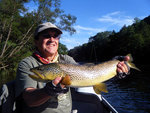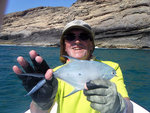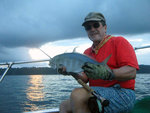 Narrowsburg
NarrowsburgLight Rain Fog/Mist, 43°
Wind: 8.1 mph
 Narrowsburg
NarrowsburgMy home waters are the Delaware River, as well as the Willowemoc and the Beaverkill, but the Delaware is my main focus. I love fishing the Delaware’s West Branch and Main Stem down to …
Stay informed about your community and support local independent journalism.
Subscribe to The River Reporter today. click here
This item is available in full to subscribers.
Please log in to continue |



My home waters are the Delaware River, as well as the Willowemoc and the Beaverkill, but the Delaware is my main focus. I love fishing the Delaware’s West Branch and Main Stem down to Buckingham for trout. I fish in “warm water” time between Narrowsburg and Barryville, NY for small mouth bass, but mostly I fish for trout, and almost always, I fish with guide Adrian LaSorte, a friend for at least 30 years. Adrian is a superb guide. If there is a fish to be caught, Adrian will find it. Then he will browbeat me into hooking and landing it and—after photos, of course—letting it go.
This past season (2015), no exception, yielded perhaps more very large browns and rainbows on tiny dry flies than in the past dozen years. With an assortment of good fishing buddies, we floated the West Branch and the Main Stem. Finding sipping beauties, we drifted our size 20 and 22 midge patterns (tiny) on 6 1/2 X tippet (extremely fine) over the rise ring countless times, until, just right… a boil, then WHAM, the strike. If we were lucky, a tug and a pull and a swimming trout to be managed most carefully, coaxed into the shallows and then to Adrian’s net for a huge “Huzzah!” and great relief all the way around.
Happily, I have been privileged to fish a lot of other places as well, all over the world. But wherever I fish, my home waters always beckon me back, and invite comparisons. Always the question, “Is this river more or less like the Delaware?” Does it compare with other Catskill streams?
Travels over the rainbow
The Jardine, on Cape York, the farthest northeastern tip of Australia, is a river that flows through the jungle, and is perfectly clear, as witnessed by our sighting a sleeping-eight foot crocodile—yikes!—in the sand underneath our boat. Once harassed, the croc made a fast exit upstream. This river, I was told and I think it is true, actually starts in Papua New Guinea, 300 miles to the north, and there goes underground, and traveling though limestone caves under the shallow sea, then arises again on the Cape York peninsula where, about the size of the West Branch of the Delaware below Deposit, it flows 20 or 30 miles into the Gulf of Carpentaria, that great sea on the north coast of that fabled continent.
There I spent a happy day with two other anglers tossing very large dry flies at such exotic species as baby tarpon, arrow fish (the fish spits at insects on a leaf three to six feet away, dropping them into the river where the fish then eats the bug), and saratogas (a strange-looking and much smaller variation on the barramundi). No, we were not attacked by any crocs or poisonous snakes, but we stayed alert, and did very little wading. The Jardine’s bottom was both rocky and often sandy, and its water gin clear, and so while it aroused reminiscences of the West Branch, it was really quite different. Also, I don’t usually hear jungle sounds, hoots and hollers of exotic birds, and occasional calls by other fauna, along the West Branch—but we did often along the Jardine.
In the Ganges, a mighty watercourse I have fished many times as it hurtles out of the mountains of northern India, I seek that famed game fish, a distant cousin of the carp, the mahseer. Moody fish, mahseer take when they wish, and often not. Water levels seem to dictate some of their behavior, but I never quite figured it out. One 24-hour period I caught over 30, including two larger ones, going nine and 14 pounds, respectively. Then the bite went dead and we were blanked for the next two days. That’s happened to me more than once with Mahseer.
Rio Gallegos is in the far southern part of Patagonia, where gargantuan brown trout swim in from the sea to torment fly fishers who seek their company. Though similar to the Delaware in volume, it is sited in wide un-treed plains, populated with rheas and guanacos. It was there that I hooked into and managed to land a magnificent fish that was estimated at 18 pounds.
The Gambia River of Senegal will not likely be confused for the Delaware or any other Catskill stream. From a bluff I watched hippopotamuses wallowing in a big pond formed by the river, where the previous day we had canoed downstream to check out some fishing spots. In the dry season, way upstream the river was but a trickle, and we found a few wallows where we cast for tiger fish and African pike, but surely no memories of the Delaware. It was fun, though, to hear the troop of baboons in the trees on the high bank as they hollered at us to get out of their territory, and we made baboon sounds and defiant gestures back at them and asserted our right to be on the river. It’s a long way from home.
Can you find a river like the Delaware closer to home? How about the South Fork of the Holston in Tennessee? Well, the geology of the area, that ultimate definer of the character of a river, is very different. With its numerous shale ledges tilted at various odd angles, it prompts no memories of the Delaware. Dry flies, yes, nice fish, yes, but not big ones like you get on the Delaware—at least I did not see them.
Perhaps you need to go to Montana for rivers that make you think of the Delaware. Rivers like the Madison around Ennis, or the Bitterroot, south of Missoula, or the Yellowstone as it courses through Paradise Valley, are all similar to the Delaware in some ways. But it is the Bighorn, just downstream from the “wedding of the waters,” where its name changes from “Wind River” to “Bighorn River,” in and below the town of Thermopolis, Wyoming that may be closest to our Delaware. There, the river is clear, deep, and rich in fly life, and accordingly also rich in large brown and rainbow trout. What a place! I have fished there a number of times and always been impressed with the abundant hatches, and impressive rises, and large fish that have occasionally graced my rod.
But when I get home, even though I have sampled all those grand waters of the world, I return to my happy place, in Adrian’s drift boat, floating the Delaware, putting in at the Farmer’s Pool upstream of Deposit, or at Ball Eddy, or wherever, and doing a long, sweet float with a good buddy in a beautiful valley. It is a very good place to fish. After a full day on the Delaware, I find that drifting off to sleep comes easily…
There’s no place like home….
There’s no place like home….
There’s no place like home.
© Terry Shultz
Comments
No comments on this item Please log in to comment by clicking here